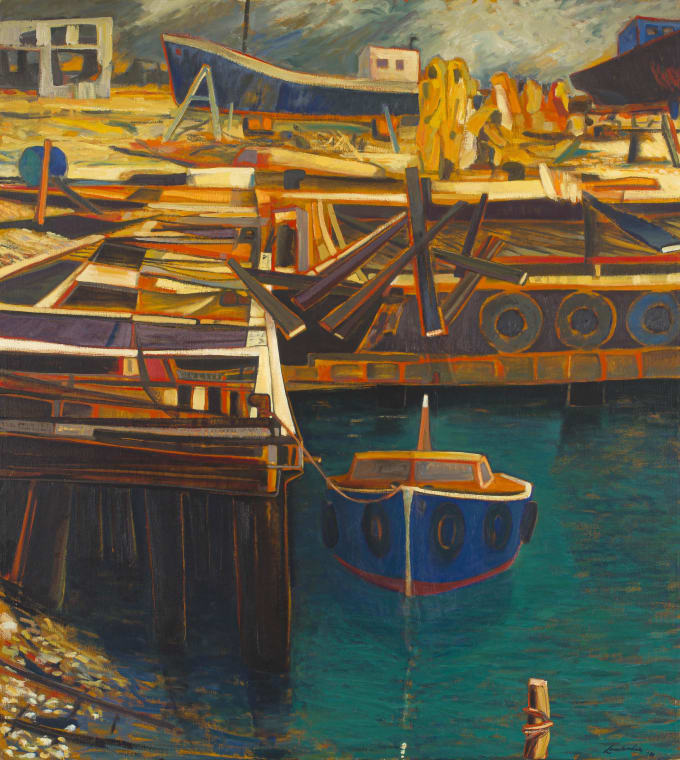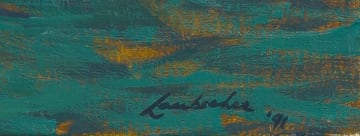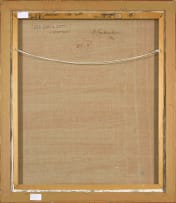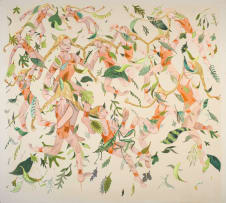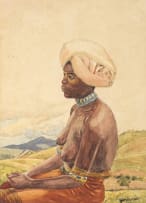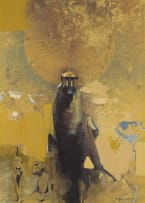Modern, Post-War and Contemporary Art, Decorative Arts and Jewellery
Live Virtual Auction, 11 - 12 October 2021
Modern and Post-War Art
Incl. Buyer's Premium & VAT
About this Item
signed and dated '91; signed, dated, and inscribed with the title on the reverse and on the stretcher
Notes
Strauss & Co pays tribute to Claude Bouscharain and Erik Laubscher.
This auction showcases eight examples of these artists' work. Spanning five decades, we hope to elaborate on their extraordinary entwined creative journey. Claude Bouscharain and Erik Laubscher met in Paris in 1950. Bouscharain had returned to Paris that year after spending four years in New York, enrolled at the Art Students League. There Bouscharain elected to study under Morris Kantor, who taught the importance of composition and good draftsmanship. Laubscher had decided to move his studies to Paris after two years in London studying under portrait artist Frank Slater and at the Anglo-French Art Centre. Fortuitously, both had chosen to study at the Académie de Montmartre where the creative influence of Fernand Léger, principal from 1947, dominated. While neither chose to emulate Léger during their time at the Académie, his later imprint in their work can be traced through well-known quotes:
"Composition takes precedence over all else. To obtain their maximum expressiveness, lines, forms and colour must be employed with the utmost possible logic…"
and "Search for a state of organized intensity… I group contrary values together… between those two kinds of relationships, which are eternal subjects for painting, I look for a relationship of intensity."1
Despite their cultural differences, the two formed a romantic relationship which was to prove pivotal in their approach to their burgeoning artistic careers. In June 1951 Laubscher returned to South Africa and settled in Cape Town. Bouscharain followed in September that year and they were married the day after she arrived.
In 1952 Laubscher made headlines when it became known that he ground his own pigments. See Lots 322 and 323, both works painted in the same year.
By 1953, Laubscher formally joined the New Group and took over the Director's position at the Contemporary School of Art (originally named the Continental School of Art). After several changes of address, the Laubschers, now a family of three, moved into 6 Cheviot Place, Green Point. The young family shared the home with a revolving door of housemates (including Jan Rabie and Marjorie Wallace). It wasn't until 1968/69 that Laubscher was able to purchase the house. Cheviot Place became known as an artistic hub where artists, poets and writers would meet informally to discuss the arts while raging against the dictates of a conservative Nationalist government. Bouscharain spent the early years raising the couple's children and painting when she could, while Laubscher focused on balancing his role as Director and developing his reputation as a contemporary artist. Laubscher found the running of the school exciting but, despite its many successes, it did not provide him and his family with sufficient financial support.
In 1955, when an opportunity arose to become a 'colour consultant' for Plascon Paints, he accepted the job. This offered Laubscher a steady income and the freedom to travel and express himself, releasing him from the restrictions of painting for the commercial market.
Despite her busy family responsibilities, in September 1959 Claude exhibited at the Under 40s Exhibition at the South African Association of Arts, also mounting a solo show in the same space. She exhibited in group shows and, in 1963, she and Erik showed together at the Lidchi Gallery in Johannesburg. In 1966 Laubscher was awarded the Carnegie Grant and the pair travelled to America. This proved a turning point in their respective artistic development as both artists made a shift from oil to acrylic, presenting new stylistic possibilities. The influence of the Precisionist-style of the 1930s and1940s combined with the hard-edge abstraction dominant in America at this time, is evident in lot 324, Bouscharain's Adam and Eve Expelled from the Garden of Eden.
In 1971 Laubscher founded the Ruth Prowse School of Art which he ran for twenty-five years. It was the only nondiscriminating art centre in South Africa.
From the late 1970s Laubscher's landscape works shifted from abstraction to a more representational style of painting. In lot 325, a rare example of a harbour scene from 1991, Old Quay 4 Jetty, Waterfront, Cape Town, Laubscher's portrayal of the subject is immediately recognisable. While including elements of abstraction in his treatment of the jetty, painterly mark-making is used in the water and sky, lending a sense of movement to the work. The derelict building on the far left in the background is reminiscent of a recurring subject in Bouscharain's paintings - unfinished buildings in varying stages of construction or demolition.
It is also interesting to note that, even though Laubscher lived close to the harbour and the sea, these subjects rarely appear in his work. He is more intrigued by inland areas, such as the Swartland, Kouebokkeveld, Namibia, Overberg, and, the Karoo. This later period in his career, titled 'Mastery' by Hans Fransen,2 is shown in lots 326 to 328.
The Erik Laubscher and Claude Bouscharain Foundation will launch in Cape Town early in 2022. The mandate for the Foundation is to build on the wishes of Laubscher in the establishment of a space where the lives and work of these two important artists can be celebrated together. Projects will include the full digitisation of the archive, a Catalogue Raisonné and exhibitions. The Foundation wishes to encourage contemporary dialogue around Laubscher and Bouscharain, placing them correctly within the timeline and trajectory of twentieth century South African art histories.
1. Hans Fransen (2009) Erik Laubscher: A Life in Art, Stellenbosch: SMAC Art Gallery, pages 22 to 23.
2. Hans Fransen (2009) Erik Laubscher: A Life in Art, Stellenbosch: SMAC Art Gallery, page 214.
Exhibited
University of Pretoria Art Gallery, Pretoria, Kaapse Kunstenaars, 20 September to 7 October 1994, catalogue number 10.
